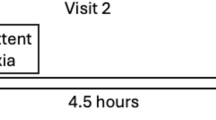Abstract
This study investigated the human erythropoietin (EPO) response to short-term hypocapnic hypoxia, its relationship to a normoxic or hypoxic increase of the haemoglobin oxygen affinity, and its suppression by the addition of CO2 to the hypoxic gas. On separate days, eight healthy male subjects were exposed to 2 h each of hypocapnic hypoxia, normocapnic hypoxia, hypocapnic normoxia, and normal breathing of room air (control experiment). During the control experiment, serum-EPO showed significant variations (ANOVAP = 0.047) with a 15% increase in mean values. The serum-EPO measured in the other experiments were corrected for these spontaneous variations in each individual. At 2 h after ending hypocapnic hypoxia (10% O2 in nitrogen), mean serum-EPO increased by 28% [baseline 8.00 (SEM 0.84) U · 1−1, post-hypoxia 10.24 (SEM 0.95) U · 1−1, P = 0.005]. Normocapnic hypoxia was produced by the addition of CO2 (10% Co2 with 10% O2) to the hypoxic gas mixture. This elicited an increased ventilation, unaltered arterial pH and haemoglobin oxygen affinity, a lower degree of hypoxia than during hypocapnic hypoxia, and no significant changes in serum-EPO (ANOVAP > 0.05). Hypocapnic normoxia, produced by hyperventilation of room air, elicited a normoxic increase in the haemoglobin oxygen affinity without changing serum-EPO. Among the measured blood gas and acid-base parameters, only the partial pressures of oxygen in arterial blood during hypocapnic hypoxia were related to the peak values of serum-EPO (r = −0.81,P = 0.01). The present human EPO responses to hypoxia were lower than those which have previously been reported in rodents and humans. In contrast with the earlier rodent studies, it was found that human EPO production could not be triggered by short-term increases in pH and haemoglobin oxygen affinity per se, and the human EPO response to hypoxia could be suppressed by concomitant normocapnia without acidosis.
Similar content being viewed by others
References
Cohen RA, Miller ME, Garcia JF, Moccia G, Cronkite EP (1981) Regulatory mechanism of erythropoietin production: effect of hypoxemia and hypercarbia. Exp Hematol 9:513–521
Dill DB, Costill DL (1974) Calculation of percentage changes in volumes of blood, plasma, and red cells in dehydration. J Appl Physiol 37:247–248
Eckardt KU, Boutellier U, Kurtz A, Schopen M, Koller EA, Bauer C (1989) Rate of erythropoietin formation in humans in response to acute hypobaric hypoxia. J Appl Physiol 66:1785–1788
Eckardt KU, Kurtz A, Bauer C (1990) Triggering of erythropoietin production is inhibited by respiratory and metabolic acidosis. Am J Physiol 258:678-R683
Eckardt KU, Koury ST, Tan CC, Schuster SJ, Kaissling B, Ratcliffe PJ, Kurtz A (1993) Distribution of erythropoietin producing cells in rat kidneys during hypoxic hypoxia. Kidney Int 43:815–823
Fandrey J, Bunn HF (1993) In vivo and in vitro regulation of erythropoietin mRNA: measurement by competitive polymerase chain reaction. Blood 81:617–623
Faura J, Gurney CW, Fried W (1968) The effect of carbon dioxide on erythropoiesis. Ann NY Acad Sci 149:456–461
Goldberg MA, Glass GA, Cunningham JM, Bunn HF (1987) The regulated expression of erythropoietin by two human hepatoma cell lines. Proc Natl Acad Sci 84:7972–7976
Jelkmann W (1992) Erythropoietin: structure, control of production, and function. Physiol Rev 72:449–489
Jelkmann W, Seidl J (1987) Dependence of erythropoietin production on blood oxygen affinity and haemoglobin concentration in rats. Biomed Biochim Acta 46:304–308
Klausen T, Dela F, Hippe E, Galbo H (1993) Diurnal variations of serum erythropoietin in trained and untrained subjects. Eur J Appl Physiol 67:545–548
Klausen T, Poulsen TD, Fogh-Andersen N, Richalet JP, Nielsen OJ, Olsen NV (1996) Diurnal variations of serum erythropoietin at sea level and altitude. Eur J Appl Physiol 72:297–302
Knaupp W, Khilnani S, Sherwood J, Scharf S, Steinberg H (1992) Erythropoietin response to acute normobaric hypoxia in humans. J Appl Physiol 73:837–840
Kokot M, Kokot F, Franek E, Wiecek A, Nowicki M, Dulawa J (1994) Effect of isobaric hyperoxemia on erythropoietin secretion in hypertensive patients. Hypertension 24:486–490
LeHir M, Eckardt KU, Kaissling B, Koury ST, Kurtz A (1991) Structure-function correlations in erythropoietin formation and oxygen sensing in the kidney. Klin Wochenschr 69:567–575
Miller ME, Howard D (1979) Modulation of erythropoietin concentrations by manipulation of hypercarbia. Blood Cells 5:389–403
Miller ME, Rørth M, Parving HH, Howard D, Reddington I, Valeri CR, Stohlman F (1973) pH effect on erythropoietin response to hypoxia. N Engl J Med 288:706–710
Miller ME, Rørth M, Stohlman F, Valeri CR, Lowrie G, Howard D, McGilvray N (1976) The effects of acute bleeding on acid-base balance, erythropoietin (Ep) production and in vivo P50 in the rat. Br J Haematol 33:379–385
Pagel H, Jelkmann W, Weiss C (1989) O2-supply to the kidneys and the production of erythropoietin. Respir Physiol 77:111–118
Pokala P, Llanera M, Sherwood J, Scharf S, Steinberg H (1995)Erythropoietin response in subjects with obstructive sleep apnea. Am J Respir Crit Care Med 151:1862–1865
Rørth M (1974) Hypoxia, red cell oxygen affinity and erythropoietin production. Clin Haematol 3:595–607
Siggaard-Andersen O, Wimberley PD, Fogh-Andersen N, Gøthgen IH (1990) Arterial oxygen status determined with routine pH/blood gas equipment and multi-wavelength hemoximetry: reference values, precision, and accuracy. Scand J Clin Lab Invest 50 [Suppl 203]:57–66
Spivak JL (1990) Serum immunoreactive erythropoietin in health and disease. Int J Cell Cloning 8:211–226
Wide L, Bengtsson C, Birgegård G (1989) Circadian rhythm of erythropoietin in human serum. Br J Haematol 72:85–90
Author information
Authors and Affiliations
Rights and permissions
About this article
Cite this article
Klausen, T., Christensen, H., Olsen, N.V. et al. Human erythropoietin response to hypocapnic hypoxia, normocapnic hypoxia, and hypocapnic normoxia. Europ. J. Appl. Physiol. 74, 475–480 (1996). https://doi.org/10.1007/BF02337729
Accepted:
Issue Date:
DOI: https://doi.org/10.1007/BF02337729




